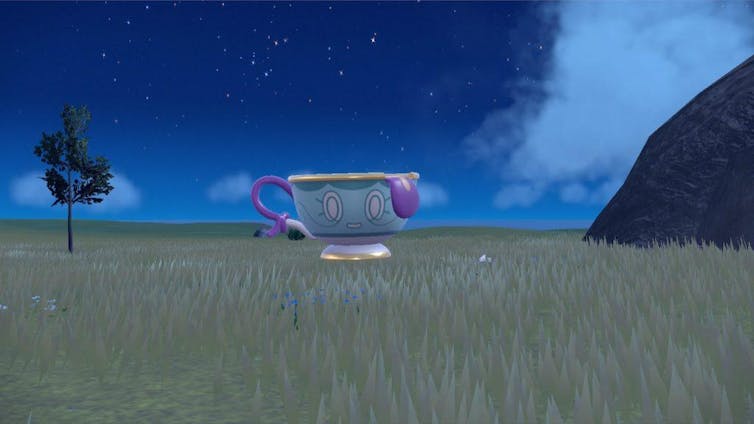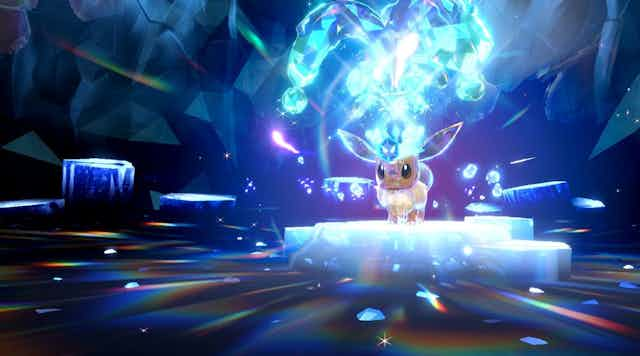Last November, Pokémon Scarlet and Violet were released for Nintendo Switch as the first so-called open-world Pokémon games. These are non-linear games in which players can freely explore the environment as they collect Pokémon characters.
Reviewers and gamers alike have generally agreed that the games succeeded in introducing changes that were long overdue such as free roaming, a less linear adventure and a large amount of collectables. But they also criticised the games’ appalling visuals and technical failures. These failures – known as “glitches” – are moments when the game fails to behave as intended. Instead of chomping on a sandwich, for example, a character might be seen munching thin air.
The original Pokémon games, Red and Blue (1996), had their fair share of glitches too. This included “MissingNo”, an unofficial critter that could be found by deliberately using glitches. But times have changed since the first games. Pokémon is now a global behemoth and must meet fans’ high expectations for visual quality.
In some ways, Scarlet and Violet’s many issues have become a blessing in disguise, however. They have fuelled an unexpected glitch-chasing frenzy.
This has contributed to the expansion of the franchise’s “headcanon”(something fans believe to be true about a franchise or character, despite a lack of evidence) and illustrated the creative potential of fan culture as players start to accept and even celebrate these glitches.
Many Pokémon fans are aware of Sinistea, for example, a ghost-type Pokémon from 2017 who is found lodging in a teacup. But in January, a few fans started to speculate and joke about whether the ghost Pokémon had been given a new form. This followed a viral Pokémon egg hatching video, recorded from the game and published on Reddit, which showed a phantom coffee cup randomly floating in the air .

While this error was due to a non-player character failing to load, fans immediately started to suggest names for the new creature, such as Caffiend, Coffantom and Sinisffee. Fan-made artworks imitating the official games were produced and a new “fakemon” was born.
As this shows, glitches aren’t simply destructive malfunctions, but also a starting point for the creation of new fan narratives.
Body horror in Pokémon Scarlet and Violet
Darker glitches have emerged too. A video recorded from the game showed a child being attacked by a Pokémon that had turned into a drill when they crossed the boundaries of the battlefield.
There was no gore, no screaming, but the contrast between the naïve, innocent tone of the Pokémon game’s universe and the violent narrative created by the recorded glitch made the video go viral.
This example is only one among many manifestations of body horror that have occurred since the release of the Scarlet and Violet games. Players have shared playthroughs showcasing avatars with spinning limbs, gigantic spaghetti-shaped bodies, or skeleton-like faces taking selfies.
As a queer game scholar I am fascinated by unorthodox and bizarre instances in gaming culture. I think that these glitches are pretty queer too.
Playing queerly means playing differently – whether it is to fail, experience “bad feelings”, be aroused or simply stray from mainstream gaming.
Queerness and horror have always shared a special relationship. Horror movies are often beloved by queer audiences, who frequently identify with the characters depicted and enjoy seeing narratives that were, and still are, missing from the mainstream film industry.
The body horror genre, with its obsession with “threatening” bodies, has resonated among the queer community. From Freaks (1932) to Titane (2021), body horror has come a long way from stigmatising to celebrating queer bodies.
And it has now found one of its most unexpected platforms – a globally successful, family-friendly digital game franchise.
‘Gotta [glitch] ’em all’
Witnessing characters becoming hugely elongated while trying to ride their bike, losing the skin on their faces while attempting to take a selfie, or moving through hard surfaces without any explanation has become common in the world of Pokémon.
Videos of these glitches have sparked conversations that go beyond the game’s original material and established glitch sharing as a way for fans to hijack the franchise.
Pokémon has been trying to be more inclusive and has increasingly showcased body diversity among its characters. There are buff women, androgynous gym leaders and curvaceous dads.
The body horror glitches, however, might have unwillingly pushed the boundaries a bit too far. Players are now not only collecting pocket monsters, but monstrous bodies too.
Their awkward presence has provided a queer twist to the traditional Pokémon journey to “become the very best”. It has encouraged players to enjoy the game’s visible failures and share the visual feats of their transgressive avatars, in the hope of becoming the glitchiest player of them all.

